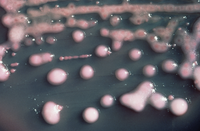
Photo from wikipedia
Polysaccharide capsule is the main virulence factor of K. pneumoniae, a major pathogen of bloodstream infections in humans. While more than 80 capsular serotypes have been identified in K. pneumoniae,… Click to show full abstract
Polysaccharide capsule is the main virulence factor of K. pneumoniae, a major pathogen of bloodstream infections in humans. While more than 80 capsular serotypes have been identified in K. pneumoniae, only several serotypes are frequently identified in invasive infections. It is documented that the capsule enhances bacterial resistance to phagocytosis, antimicrobial peptides and complement deposition under in vitro conditions. However, the precise role of the capsule in the process of K. pneumoniae bloodstream infections remains to be elucidated. Here we show that the capsule promotes K. pneumoniae survival in the bloodstream by protecting bacteria from being captured by liver resident macrophage Kupffer cells (KCs). Our real-time in vivo imaging revealed that blood-borne acapsular K. pneumoniae mutant is rapidly captured and killed by KCs in the liver sinusoids of mice, whereas, to various extents, encapsulated strains bypass the anti-bacterial machinery in a serotype-dependent manner. Using capsule switched strains, we show that certain high-virulence (HV) capsular serotypes completely block KC’s capture, whereas the low-virulence (LV) counterparts confer partial protection against KC’s capture. Moreover, KC’s capture of the LV K. pneumoniae could be in vivo neutralized by free capsular polysaccharides of homologous but not heterologous serotypes, indicating that KCs specifically recognize the LV capsules. Finally, immunization with inactivated K. pneumoniae enables KCs to capture the HV K. pneumoniae. Together, our findings have uncovered that KCs are the major target cells of K. pneumoniae capsule to promote bacterial survival and virulence, which can be reversed by vaccination.
Journal Title: PLoS Pathogens
Year Published: 2022
Link to full text (if available)
Share on Social Media: Sign Up to like & get
recommendations!